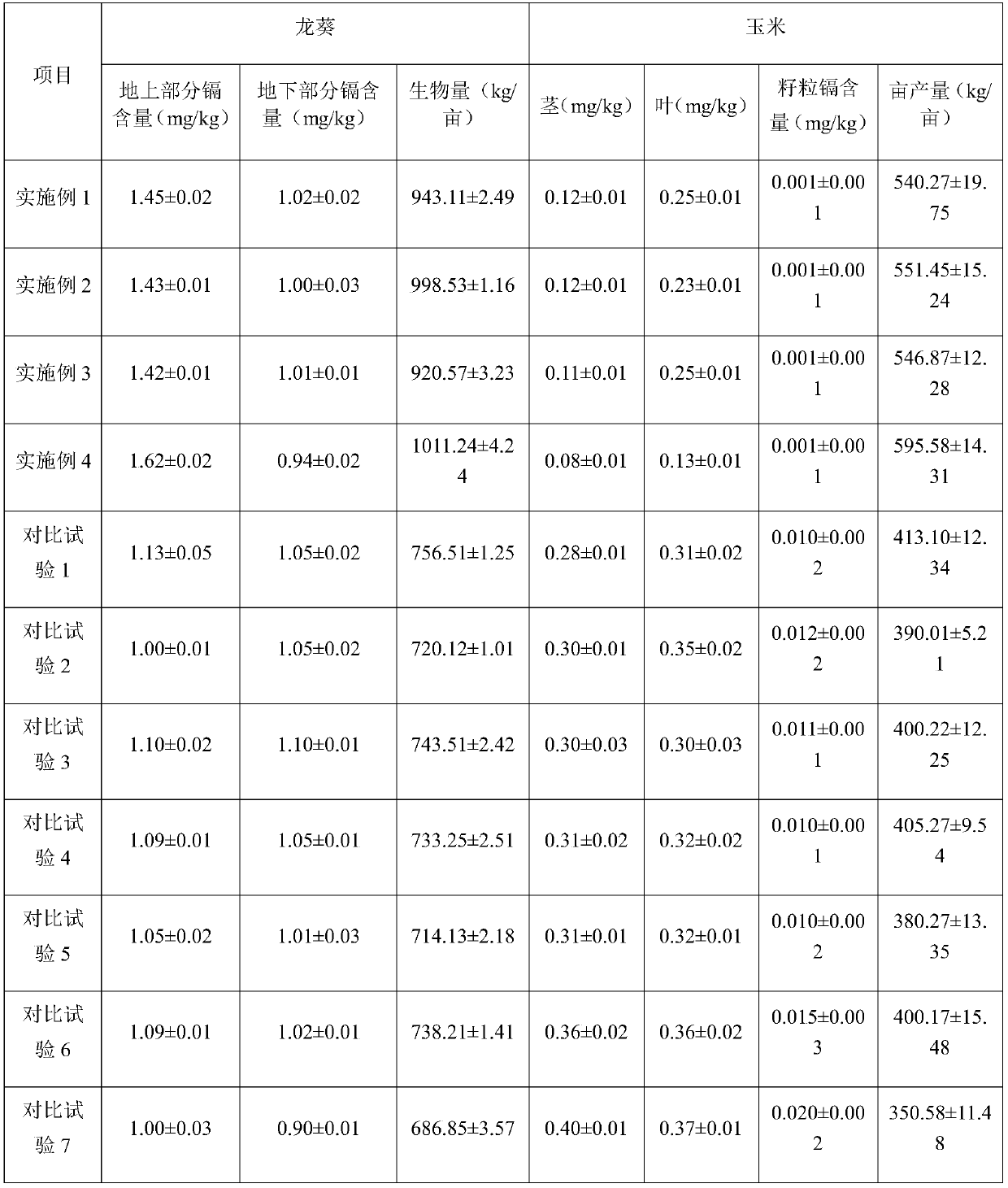Method for remediating cadmium-contaminated soil by utilizing solanum nigrum and corn intercropping plants
A cadmium-contaminated soil and phytoremediation technology, which is applied in the field of phytoremediation of cadmium-contaminated soil by using nightshade and corn intercropping, can solve the problem that the absorption efficiency of heavy metal pollutants is not high enough, the biomass of nightshade is not large, and the quality and economic benefits of corn cannot be guaranteed. To achieve the effect of promoting germination as soon as possible, reducing deposition distribution and increasing germination rate
- Summary
- Abstract
- Description
- Claims
- Application Information
AI Technical Summary
Problems solved by technology
Method used
Image
Examples
Embodiment 1
[0031] Select 0.5 mu of arable land as a demonstration field, and do three repeated experiments. First, soak the Solanum nigrum seeds with the soaking solution at a temperature of 25°C, take them out and dry them after 8 hours; the mass-component ratio of the soaking solution is 3:0.8:2:2:10 : 60% pullulan, phytase, gibberellin, sodium carbonate, calcium nitrate, sterile water mixed directly;
[0032] Before sowing, prepare the land, apply 45 kg of three-element compound fertilizer per mu as base fertilizer, and plow 30 cm;
[0033] When sowing, first plant corn, the reserved row width of corn is 80cm, and the distance between corn plants is 25cm. Sowing nightshade will be carried out after 8 days after the emergence of corn seedlings. 2 plants;
[0034] After the wild nightshade blooms, apply 15kg / mu of fortified fertilizer to corn and wild nightshade, and the fortified fertilizer includes phytic acid, glycolic acid, and manganese sulfate with a mass component ratio of 12:7:...
Embodiment 2
[0045] Select 0.5 mu of arable land as a demonstration field, and do three repeated experiments. First, soak Solanum solanum nigrum seeds with the soaking solution at a temperature of 23°C, take them out and dry them after 12 hours; the mass-component ratio of the soaking solution is 3:0.5:2.8: 2:10:45 pullulan, phytase, gibberellin, sodium carbonate, calcium nitrate, and sterile water are directly mixed;
[0046] Before sowing, prepare the land, apply 50 kg of three-element compound fertilizer per mu as base fertilizer, and plow 25 cm;
[0047] When sowing, first plant corn, the reserved row width of corn is 70cm, and the distance between corn plants is 30cm. After 5 days after the emergence of corn, nightshade is sown. Solanum solanum is planted by hole sowing, and the hole distance is 30cm. 1 plant;
[0048] After the wild nightshade blooms, apply 20kg / mu of fortified fertilizer to corn and wild nightshade, and the fortified fertilizer includes phytic acid, glycolic acid, ...
Embodiment 3
[0051] Select 0.5 mu of arable land as a demonstration field and do three repeated experiments. First, soak Solanum solanum nigrum seeds with the soaking solution at a temperature of 28°C, take them out and dry them after 5 hours; the mass-component ratio of the soaking solution is 3:1:1.5: 2:10:70 pullulan, phytase, gibberellin, sodium carbonate, calcium nitrate, sterile water mixed directly;
[0052] Before sowing, prepare the land, apply 40kg of three-element compound fertilizer per mu as base fertilizer, and plow 35cm;
[0053] When sowing, first plant corn, the reserved row width of corn is 90cm, and the distance between corn plants is 20m. After 10 days of corn emergence, nightshade is sown. Solanum solanum is planted by hole sowing, and the distance between holes is 20cm. 3 plants;
[0054] After the wild nightshade blooms, apply 10kg / mu of fortified fertilizer to corn and wild nightshade, and the fortified fertilizer includes phytic acid, glycolic acid, and manganese ...
PUM
 Login to View More
Login to View More Abstract
Description
Claims
Application Information
 Login to View More
Login to View More - R&D Engineer
- R&D Manager
- IP Professional
- Industry Leading Data Capabilities
- Powerful AI technology
- Patent DNA Extraction
Browse by: Latest US Patents, China's latest patents, Technical Efficacy Thesaurus, Application Domain, Technology Topic, Popular Technical Reports.
© 2024 PatSnap. All rights reserved.Legal|Privacy policy|Modern Slavery Act Transparency Statement|Sitemap|About US| Contact US: help@patsnap.com










